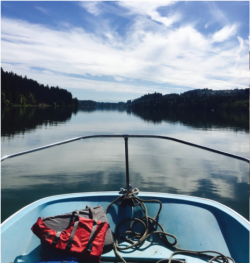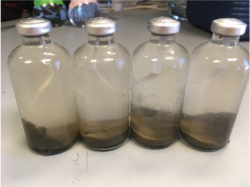Sofia D’Ambrosio, Ph.D. Candidate, Washington State University Vancouver
Lakes and reservoirs are a significant source of methane (CH4), a potent greenhouse gas with important global effects on climate (Bastviken et al. 2004; Deemer et al. 2016; St. Louis et al. 2000). In lakes, microbes produce CH4 during decomposition of organic matter in low-oxygen, carbon-rich sediments. Bacteria consume some produced CH4 via a microbial process called CH4 oxidation. However, a significant amount of CH4 avoids oxidation and is ultimately emitted to the atmosphere. Given that the balance between CH4 production and oxidation ultimately determines CH4 emission, understanding environmental controls on both processes is a critical step towards accurately estimating greenhouse gas emissions from lakes.
The thermal stratification that develops in many lakes during the summer is likely an important yet poorly understood control on methane production and oxidation. The lack of water column mixing during thermal stratification in some lakes causes a “redox cascade,” or a gradual depletion of oxygen, nitrate, sulfate, and other oxidized compounds in the hypolimnion over the course of the summer (Deemer and Harrison 2019). The resulting hypolimnetic anoxia likely stimulates methane production, strictly an anaerobic process. Additionally, the redox cascade may slow the rate of methane oxidation, a microbial process that requires the presence of oxygen, nitrate, sulfate, or other electron acceptors. Taken together, the potential increase in methane production and decrease in methane oxidation during thermal stratification are likely important controls on annual methane emissions from many lakes.
To tackle this knowledge gap, my study asks the question: how does the redox cascade observed in the hypolimnion during thermal stratification affect rates of methane production and oxidation? My first hypothesis is that rates of methane production—a strictly anaerobic process—will increase as the lake stratifies and oxygen is depleted. My second hypothesis is that rates of methane oxidation—a process that requires CH4 and an electron acceptor such as oxygen, nitrate, or sulfate—will initially increase as CH4 concentrations rise during summer stratification, but eventually fall as oxygen, nitrate, and sulfate are depleted.
I chose Lacamas Lake, a small eutrophic lake in Camas, Washington, as my study site (Fig. 1). Lacamas is an ideal study system because previous work suggests it exhibits high methane emissions (Deemer et al. 2016; Harrison et al. 2017), experiences a redox cascade each summer (Deemer and Harrison 2019), and hosts an active community of methane-producing and methane-oxidizing microbes (Reed et al. 2017).
In summer 2019, I started a series of incubation experiments to answer my question. Starting in late May, I took samples of sediment and water from Lacamas approximately every month throughout summer stratification. Back in the lab, I placed the sediment and water in glass vials (Fig. 2), injected a small amount of isotopically labeled 13CH4 gas, and incubated the vials for six hours at in situ temperature. To some of the vials, I also added extra oxygen, CH4, nitrate, or sulfate to determine how these factors influence production or oxidation rates. I took samples to measure concentrations of CH4 and 13CH4 every few hours in all vials. Comparing the concentrations of both gases allows me to calculate methane production and oxidation rates in the vials.
My incubation experiments are still underway until October, so I am still in the process of analyzing the data. Preliminary results from sampling from early and mid-summer indicate that CH4 production and oxidation are not as sensitive to inputs of CH4, oxygen, nitrate, and sulfate as I initially hypothesized. Up next is analyzing the isotopic data, which will indicate how CH4 production and oxidation change over the course of the summer. Given that lake thermal stratification is a common phenomenon that is expected to increase in strength and duration in many lakes due to climate change (Butcher et al. 2015; Sahoo et al. 2016), my results will advance fundamental understanding of current and future controls on CH4 emissions from stratified lakes worldwide. It will also provide important insight into how human management decisions that affect the bottom water chemistry of lakes and reservoirs may influence seasonal methane dynamics.
References
Bastviken, David, Jonathan Cole, Michael Pace, and Lars Tranvik. 2004. “Methane Emissions from Lakes: Dependence of Lake Characteristics, Two Regional Assessments, and a Global Estimate.” Global Biogeochemical Cycles 18(4): 1–12.
Butcher, Jonathan B., Daniel Nover, Thomas E. Johnson, and Christopher M. Clark. 2015. “Sensitivity of Lake Thermal and Mixing Dynamics to Climate Change.” Climatic Change 129(1–2): 295–305.
Deemer, B.R., and J.A. Harrison. 2019. “Summer Redox Dynamics in a Eutrophic Reservoir and Sensitivity to a Summer’s End Drawdown Event.” Ecosystems.
Deemer, Bridget et al. 2016. “Greenhouse Gas Emissions from Reservoir Water Surfaces: A New Global Synthesis.” BioScience 66(11): 949–64.
Harrison, J., B. Deemer, M.K. Birchfield, and M.T. O’Malley. 2017. “Reservoir Water-Level Drawdowns Accelerate and Amplify Methane Emissions.” Environmental Science & Technology 51(3): 1267–1277.
St. Louis, Vincent L. et al. 2000. “Reservoir Surfaces as Sources of Greenhouse Gases to the Atmosphere: A Global Estimate.” BioScience 50(9): 766.
Reed, Daniel C., Bridget R. Deemer, Sigrid van Grinsven, and John A. Harrison. 2017. “Are Elusive Anaerobic Pathways Key Methane Sinks in Eutrophic Lakes and Reservoirs?” Biogeochemistry 134(1–2): 29–39.
Sahoo, G. B. et al. 2016. “Climate Change Impacts on Lake Thermal Dynamics and Ecosystem Vulnerabilities.” Limnology and Oceanography 61(2): 496–507.











